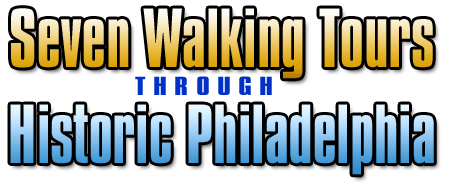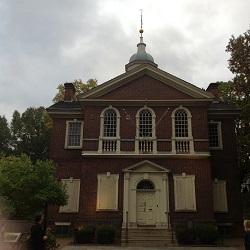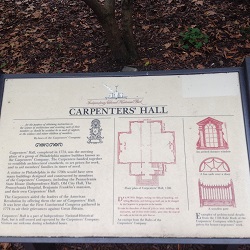Carpenters' Hall
To the east side of 4th St. between Walnut and Chestnut Streets, you'll see Carpenters' Hall — where the First Continental Congress met in 1774. This landmark building was erected between 1770 and 1774 by the Carpenters' Company, the oldest builders' organization in the United States (formed in 1724). Carpenters were architects as well as builders in those days, it should be noted.
The Company published a book of rules and prices for its members in 1786. Articles and Rules was also a pattern book, and its use was restricted to members of the Carpenters' Company who faced expulsion if they showed it to outsiders. There is an amusing story of Thomas Jefferson's writing for a copy of the book in 1817, but even the former President — an amateur architect — was denied access to the secrets of the Carpenters' Company.
Carpenters' Hall has always stood out architecturally. Its proportions are perfect; it has a sense of balance, of time and place, and it was designed to endure. The Carpenters' Company still owns and maintains the building and holds meetings here. From September 5 to October 26, 1774, the First Continental Congress met in the eastern half of the bottom floor. Robert Smith, who designed the building for use as a guild hall (restored in 1857, and opened to the public), was a member of the Second Continental Congress in 1775, and Samuel Rhoads of the Carpenters' Company was a delegate to the First Continental Congress.
Immediately to the north of Carpenter's Hall is the New Hall Military Museum
Independence Hall Area
- Welcome to the Independence Hall Area
- Welcome Park
- City Tavern
- Merchant's Exchange
- First Bank of the United States
- Old Visitor Center
- Bishop White House
- Walnut Street Garden and Houses
- The Philadelphia Contributionship
- Todd House (Dolley Madison)
- Carpenters' Hall
- New Hall (Military Museum)
- Pemberton House
- Franklin Court
- Second Bank
- Library Hall
- Philosophical Hall
- Independence Square
- Independence Hall, Congress Hall, Old City Hall
- Atwater Kent Museum
- Graff House
- President's House
- Liberty Bell




